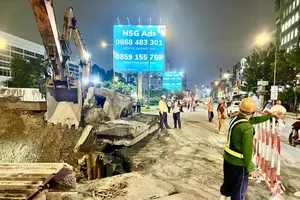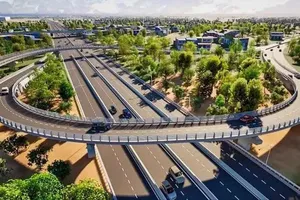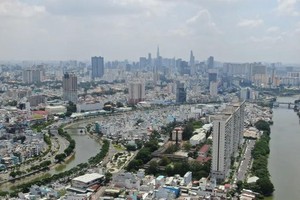
For the past several years, the side of the high-rise building at 432-436 Nguyen Thi Minh Khai Street in Ward 5 of District 3 has served as an informal garbage collection point. After compactor trucks collect the waste, the empty pushcarts are often left abandoned on the sidewalk or even in the street. On some days, the carts are overflowing with trash, loosely covered by a tarp; on others, they are left open, with garbage strewn about and foul-smelling leachate seeping onto the pavement.
Yesterday at noon, at this very location, one garbage-filled pushcart was observed on the roadside, while on the sidewalk, six more carts were clustered in two groups under tarps. Piled up at the base of a nearby tree were styrofoam boxes, plastic baskets, and nylon bags. This collection point is situated directly beside the entrance to a state agency’s office building, which houses thousands of employees. Pedestrians are forced to endure the putrid smell emanating from the waste.
About 50 meters away, at around 8:00 p.m. on June 11, three carts overflowing with trash were parked on the street at the intersection of Nguyen Thi Minh Khai and Nguyen Thuong Hien, directly in front of a food establishment. Ms. N., a local resident, lamented, “Every day from about 7:00 p.m. to 11:00 p.m., the garbage carts are gathered here. The stench is unbearable. A few weeks ago, we reported it to the local authorities, and the situation improved, but after a few days, it was back to square one.”
During the same time frame, at 442 Nguyen Thi Minh Khai Street – the location of a bank – approximately eight uncovered garbage carts were parked, with leachate trickling onto the road. An operating restaurant sits right next to this spot. In total, a stretch of less than 100 meters on this street hosts three separate garbage collection points, with carts encroaching on both sidewalks and roadways.
This scene repeats itself across the city center. At the head of Ham Nghi Street in District 1, collection carts regularly congregate in the afternoon, forcing many local and international tourists to cover their noses as they pass.
Even on the iconic Nguyen Hue Pedestrian Street, garbage carts have recently been seen lined up along the promenade. “I don't understand why garbage carts are appearing in such an ideal place, where people come to exercise and breathe fresh air”, said an exasperated Nguyen Thanh Thao, who regularly works out in the area.

Chairwoman Vu Thi Tuong Vy of District 3 Public Service Co. Ltd. explained the reason for the unexpected appearance of such disturbing scenes, saying that District 3 previously had six official garbage transfer stations. However, the city implemented a policy to dismantle these stations to improve the urban landscape in the central district.
“Without transfer stations, we are forced to create temporary collection points along the roads”, she said, while asserting that her company follows all procedures regarding timing and cleaning.
In contrast, Deputy Head Tran Huu Tai of District 3's environment division stated that these points are subject to strict time regulations. “Collection should occur around 10:00 p.m. when the streets are less busy, and the entire process from collection to transport should take no more than 60 minutes”, he said.
He attributed the problem to workers starting their rounds early to avoid potential rain, which prolongs the time trash sits on the street. “We will work with the collection units to enforce the collection times and require them to thoroughly clean these points after the waste is collected”, the Deputy Head affirmed.
District 1 Public Service Co. Ltd. noted that their collection points are registered with and approved by the Department of Construction. However, they blame delays on traffic congestion, as the compactor trucks often get stuck while traveling from their depot in District 12. They encouraged residents to report any issues directly to the company.
Director Pham Viet Luan of the HCMC Institute of Economics Environmental and Resources commented that regulations do not permit waste collection teams to use road surfaces for transferring garbage between vehicles. However, due to the unique situation in central districts, which lack proper transfer stations, this practice persists.
If the collection process is swift and meets environmental hygiene standards, it might be tolerated by the public. But if the process is prolonged and unhygienic, seriously affecting residents’ daily lives, people should report it so that functional agencies and local authorities can intervene and definitively resolve the issue.
























